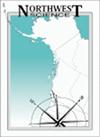加利福尼亚州太平洋马氏体两个亚种的比较繁殖生态学
IF 0.5
4区 环境科学与生态学
Q4 ECOLOGY
引用次数: 4
摘要
摘要准确的生殖生态学信息是制定濒危野生动物保护措施的必要条件。我们的目的是描述两种野生、未被捕获的太平洋貂亚种(洪堡貂、洪堡貂、洪堡貂;瑟兰·马丁,m.c.瑟兰)在加州的保护利益。研究人员使用无线电遥测技术和远程触发相机,在23个总周期内监测了10只洪堡貂(2014年至2016年)和6只雪貂(2016年至2017年)。洪堡貂平均产仔日期为4月13日,成虫繁殖率为80% (n = 12 / 15),平均产仔数为1.8±0.6只(x′±SD)。平均产仔日期为4月29日,成虫繁殖率为87% (n = 7 / 8),平均产仔数为1.9±0.7只。洪堡貂和雪貂的洞穴主要分布在木质结构中,活树、树枝和原木分别占洞穴的91%和79%。尽管洪堡貂和雪貂的生殖生态基本相似,但雪貂的分娩日期明显晚于洪堡貂。我们将我们的研究种群与其他北美貂种群进行比较,并检查可能影响种群间生殖参数一致性或可变性的因素。本文章由计算机程序翻译,如有差异,请以英文原文为准。
Comparative Reproductive Ecology of Two Subspecies of Pacific Marten (Martes caurina) in California
Abstract Accurate information on reproductive ecology is necessary to develop conservation actions for at-risk wildlife species. Our objective was to describe female reproductive parameters and den use of two subspecies of wild, untrapped Pacific martens (Humboldt marten, Martes caurina humboldtensis; Sierran marten, M. c. sierrae) of conservation interest in California. We used radio telemetry and remotely triggered cameras to monitor 10 Humboldt martens (2014 to 2016) and six Sierran martens (2016 to 2017) over 23 total denning periods. For Humboldt martens, mean parturition date was 13 April, proportion of adult females reproducing was 80% (n = 12 of 15), and mean litter size was 1.8 ± 0.6 kits (x̄ ± SD). For Sierran martens, mean parturition date was 29 April, proportion of adult females reproducing was 87% (n = 7 of 8), and mean litter size was 1.9 ± 0.7 kits. Humboldt and Sierran marten dens were predominantly located in woody structures, with live trees, snags, and logs comprising 91% and 79% of dens, respectively. Although reproductive ecologies of Humboldt and Sierran martens were largely similar, Sierran marten parturition dates were significantly later. We compare our study populations to other North American marten populations and examine factors that could influence consistency or variability in reproductive parameters between populations.
求助全文
通过发布文献求助,成功后即可免费获取论文全文。
去求助
来源期刊

Northwest Science
环境科学-生态学
CiteScore
1.30
自引率
0.00%
发文量
23
审稿时长
>36 weeks
期刊介绍:
The pages of Northwest Science are open to original and fundamental research in the basic, applied, and social sciences. All submissions are refereed by at least two qualified peer reviewers. Papers are welcome from authors outside of the Pacific Northwest if the topic is suitable to our regional audience.
 求助内容:
求助内容: 应助结果提醒方式:
应助结果提醒方式:


